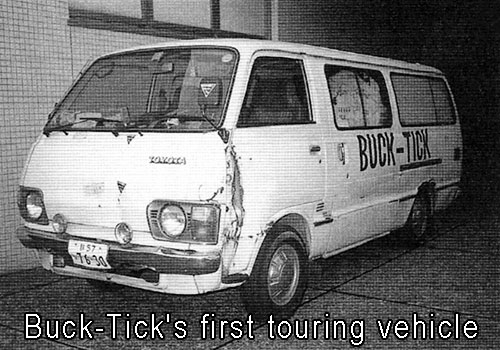1986
Now that the line-up is settled and all the members are living in Tokyo, it's time to get serious. This is the first year where the number of shows they play in the year are in the double digits. The year started off with a gig on January 15 at Gunma Kaikan in Maebashi. They played at Toritsu Kasei Kindo in Tokyo on January 19 and April 12. They played at Shinjuku ACB on February 6 and May 21. They played at Shibuya Yaneura on April 14, June 8, June 28, and August 1 and 25.
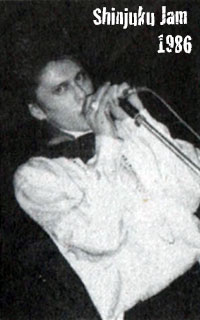 This is the year that Buck-Tick started to become popular in the underground scene, known as "Indies" in Japan (short for independent). Though this is perhaps a very different scene from what later became the Indies scene in the '90s and after. Buck-Tick played at the Beat For Beat For Beat series of unsigned band gigs held at Shinjuku Jam throughout the year. They participated at Beat For Beat For Beat Vol.3 on January 28, Vol.4 on February 8, Vol.5 on March 20, Vol.6 on May 10, Vol.7 on July 24, Vol.8 on August 22, and Vol.9 on September 26. As they play more shows, the band notices that the audience is not just their friends anymore.
This is the year that Buck-Tick started to become popular in the underground scene, known as "Indies" in Japan (short for independent). Though this is perhaps a very different scene from what later became the Indies scene in the '90s and after. Buck-Tick played at the Beat For Beat For Beat series of unsigned band gigs held at Shinjuku Jam throughout the year. They participated at Beat For Beat For Beat Vol.3 on January 28, Vol.4 on February 8, Vol.5 on March 20, Vol.6 on May 10, Vol.7 on July 24, Vol.8 on August 22, and Vol.9 on September 26. As they play more shows, the band notices that the audience is not just their friends anymore.
As far as what exactly becoming popular means, Hisashi recounts in an interview that at first they had perhaps 30 people at a show and then after they were mentioned in a magazine, they would have around 80 people at a show and built it up from there. However, they were still quite poor. The little money they did make from a gig was immediately spent on alcohol as they would party after playing. (This drinking after a show became quite notorious with the band for several years as they would drink until the sun came out and Japanese bars can be hospitable towards such customers.) As far as how poor the band was during those days, I recall an interview where they said that when they started out, they had so little money that after shows for food they could only afford to buy one takoyaki and had to split it between not only the members of the band but their one roadie as well. [I'm assuming this was a set of takoyaki because just 1 takoyaki is an extremely small amount of food. It's like saying they bought one french fry instead of an order of french fries.] There are also tales of Hide only eating miso because he was so poor. And then of course there are the various tales of odd jobs they held. The following year they would gain a stylist and she later described that when she first met the band, they were so skinny that they looked ill.
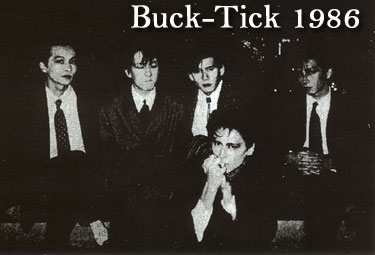
Aside from the Beat For Beat For Beat shows, Buck-Tick played at Shinjuku Jam on April 17 and June 13.
In April, "Doll" magazine published Buck-Tick in their newcomer's profile corner. I believe this was their first appearance in a magazine.
The band decided to record a demo and were able to get into a Yamaha studio at a fair price because of a connection Toll had from his days in S.P through the Popcon event. The cost of Yamaha Hiyoshi Center Studio was ¥100,000, which came down to ¥20,000 per member. That was quite a lot of money for them but they somehow managed to come up with the money. [For reference, the minimum wage in Tokyo in 1986 was ¥488 per hour. If a member had a minimum wage job, they would have to work 41 hours to pay for their share of the recording studio fee, roughly a week's wages.] They were unfamiliar with the recording process and recorded what they thought to be their four best songs ("Plastic Syndrome II", "To-Search", "One Night Ballet", "Secret Reaction") in one day (around May 18). Looking back, U-ta laughed that they didn't even know what a click track was. [Note: "Plastic Syndrome II" was later named "Plastic Syndrome Type II".]
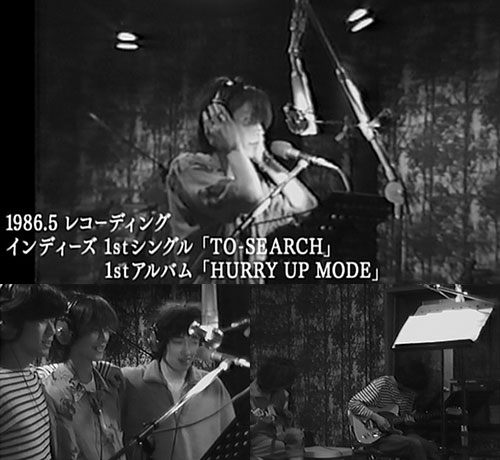
The band returned to play in their home prefecture of Gunma on May 3 at the Maebashi Rattan, June 22 and July 27 at Takasaki Bibi, and November 5 at Takasaki Shimin Bunka Kaikan.
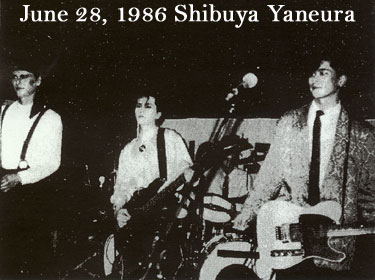
The head of the infamous Japanese indie label Taiyo Records [Sun Records], Kasumi Sawaki, (also known as Kazumi Sawaki, Kazuyo Sawaki, Kazunori Sawaki, and Genius Sawaki), saw them at a gig in Shibuya on June 28. He loved it enough that he contacted them by phone in July. When they met he told them that they would definitely sell and eventually they were signed. (To get a sense of what Buck-Tick's sound and stage presence was around this time, search for video footage of the June 22 show at Takasaki Bibi. It was recorded with multiple cameras but I am not sure for which television program, probably a local one.)
Side note on Kasumi Sawaki and Taiyo Records. Sawaki is about 11 years older than Toll and picked up a guitar when he was 21 years old. Sawaki used his label to release his works such as Hi No Kyuu (AKA hinoQ, which means Fire Sign). The other member of that group was Nozomu Naka, who would compose "Theme of B-T" which is sometimes played before Buck-Tick gigs. Apparently, the song started out "Theme of Sawaki" but it ended up going to Buck-Tick. To which, Sawaki is still upset with Victor about. Nozomu would also end up releasing some of his solo works on Victor. Sawaki decided to quit being a musician in 1986 and focus on developing Taiyo Records instead, signing several punk bands. The first band he signed was Geil in early 1986. Geil released a 7" single entitled "I'm" (LEO-003) in 1986. The next bands to sign and release something on Taiyo Records were Genkaku Mime, Trash, and Kyoaku Kyojindan. All of these releases were singles on vinyl. Then Buck-Tick released "To-Search" as a 7" single (LEO-007). Other bands that later had releases on Taiyo Records include The Eden, The Street Beats, and Soft Ballet. Soft Ballet released "Body to Body" as a 3" single (LEO-018) in 1989. Sawaki really believed strongly that The Eden would break bigger than Buck-Tick managed to but alas, that was not to be. After Soft Ballet's single release in 1989, Sawaki took a short break and went to Australia, then returned to Japan and focused on producing reggae in the early 1990s. He revived Taiyo Records in 2010 to re-issue 2 of his own albums on CD. Buck-Tick would go on to sign with Victor/Invitation in 1987 and become the most successful and longest lasting artist to come out of Taiyo Records. Genkaku Mime were on a compilation video on Victor/Invitation in 1988 then seemingly disappeared. The Street Beats were signed to Victor/Invitation in 1988. Soft Ballet signed to Alfa/Edge Records in 1989 then moved to Victor/Invitation in 1992.
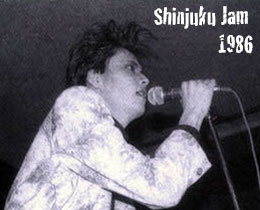 It should be noted that several of these early gigs were multiple bands playing the same night as evidenced by fliers and photos of Toll playing The Eden's drumset, such as the August 25 gig at Shibuya Yaneura, even though the official books do not list that the band were a guest for that gig. I assume then that Buck-Tick was the headliner but borrowed the equipment of the opener. Or simply, it's just an overlooked detail as the books have errors here and there. The Eden were another band signed to Taiyo Records who released a single in 1987. Another notable gig with others is the June 8 show at Shibuya Yaneura as the other bands were Rogue and The Collectors. The singer/guitarist of Rogue is Atsushi Okuno, who formed a side project with U-ta in 2004 called Wild Wise Apes. Kosaku Abe was the drummer of The Collectors since 1986 but they had another drummer in 1986 as well so I am not sure if he played at this particular gig. Kosaku played drums on Atsushi's solo album in 2004 as well as during the live shows.
It should be noted that several of these early gigs were multiple bands playing the same night as evidenced by fliers and photos of Toll playing The Eden's drumset, such as the August 25 gig at Shibuya Yaneura, even though the official books do not list that the band were a guest for that gig. I assume then that Buck-Tick was the headliner but borrowed the equipment of the opener. Or simply, it's just an overlooked detail as the books have errors here and there. The Eden were another band signed to Taiyo Records who released a single in 1987. Another notable gig with others is the June 8 show at Shibuya Yaneura as the other bands were Rogue and The Collectors. The singer/guitarist of Rogue is Atsushi Okuno, who formed a side project with U-ta in 2004 called Wild Wise Apes. Kosaku Abe was the drummer of The Collectors since 1986 but they had another drummer in 1986 as well so I am not sure if he played at this particular gig. Kosaku played drums on Atsushi's solo album in 2004 as well as during the live shows.
On September 10, Buck-Tick played at Taiyo Matsuri [Sun Festival] along with Genkaku Mime who were also signed to Taiyo Records and had already released a single.
On October 19 and November 1, Buck-Tick played at a festival at a university. It is common for some Japanese universities to have festivals where several bands play. The October 19 gig was at Bunkyo Women's University, AKA Bunkyo Junior College (Bunkyo Jyoshi Tanki Daigaku), where Hide's cousin attended, hence why they played there. It had two campuses, later became co-educational, and was renamed. The Saitama campus in Fujimino City was the Women's University. They brought their first single ahead of its official release and sold around 30 copies. I do not know further details about the November 1 gig at Saitama University but that university is located in Saitama City and some photos have emerged from that show. Though Saitama is much like the suburbs of Tokyo, it is important to note that these university gigs were the first time that Buck-Tick played outside of their home prefecture of Gunma and their new home of Tokyo.
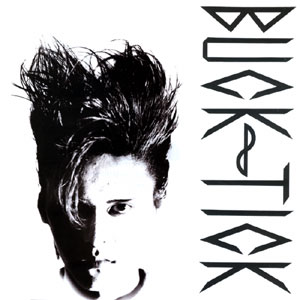 On October 21, Buck-Tick's first release was the "To-Search" single on Taiyo Records (pictured). The song lyrics and music were written by Hisashi. The B-side was "Plastic Syndrome Type II". The version of the songs were extracted from the demo they had recorded themselves in May. The following day they held a single commemoration gig at Shinjuku Loft with around 200 in attendance, but in some interviews they cite a number as low as 160. (Venue capacity is around 500.) There were reportedly only 1000 copies of this single made. This first release is notable for the typos. Hisashi's name is incorrectly listed as Kotobuki due to his kanji more commonly being read that way. The credit for Toll's name is spelled Tohru when he prefers Toll. Additionally, his last name was misspelled as Yamagami instead of Yagami. There is a typo and a slight variance to the B-side as it was printed as "Plastic Symdrome Type-2".
On October 21, Buck-Tick's first release was the "To-Search" single on Taiyo Records (pictured). The song lyrics and music were written by Hisashi. The B-side was "Plastic Syndrome Type II". The version of the songs were extracted from the demo they had recorded themselves in May. The following day they held a single commemoration gig at Shinjuku Loft with around 200 in attendance, but in some interviews they cite a number as low as 160. (Venue capacity is around 500.) There were reportedly only 1000 copies of this single made. This first release is notable for the typos. Hisashi's name is incorrectly listed as Kotobuki due to his kanji more commonly being read that way. The credit for Toll's name is spelled Tohru when he prefers Toll. Additionally, his last name was misspelled as Yamagami instead of Yagami. There is a typo and a slight variance to the B-side as it was printed as "Plastic Symdrome Type-2".
All the gigging and self-promotion was beginning to really pay off. Buck-Tick was getting popular enough in the Indies circuit that in November the first Buck-Tick fan club newsletter was issued. It was called "Full Volume" and Hide's cousin was in charge of it. It ran for 4 issues and was in black and white. There's rumors that more issues exist in color but I have never seen photographic proof to substantiate this claim. The issues featured member profiles, member equipment soundchecks, and gig reviews. [It should be noted that if you have seen issue 5, it was not part of the official "Full Volume" but rather a fanzine created later.]
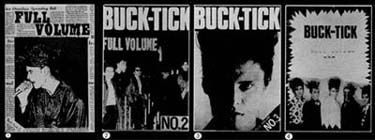
On December 15, Buck-Tick played at Shibuya La-Mama, which has a capacity of around 250. (There is some dispute as to the date as one book lists it as November 15.) On December 21, they played at a show entitled "All Night" at Shibuya La-Mama. This date is incorrectly listed as on the 10th in one of the books. Fan photos of this gig that have surfaced confirms this show was on the 21st. The final gig of the year was on the 29th at Shibuya Take Off 7. This is Buck-Tick's first December 29 gig, although it has nothing to do with their future December 29 gigs entitled "The Day In Question".
Needless to say, the band was still quite poor and were touring around from gig to gig in a beat up van. It wasn't very reliable and would break down at times. They evenly divided the payments so that each member had to pay ¥2,000 each month. They used tape to write "Buck-Tick" on the side of the van.
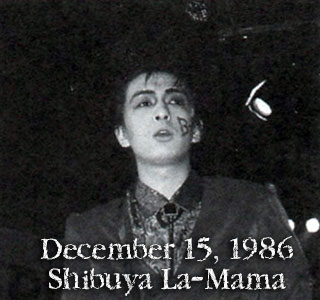 Since their days as Hinan Go-Go, the band has utilized make-up as part of their look, particularly Hisashi. In fact, if you're already a fan of the band and came here to learn more about their early days, then you know that Hisashi always writes "B-T" on his left cheek when he's working as a member of Buck-Tick. (Some photoshoots for interviews may be without make-up.) I haven't pinned down exactly when he started writing "B-T" as a lot of the early concert photos don't have a good view of his face but as you look through photos from 1986, it's clear that he probably didn't start writing "B-T" until the later half of the year if not the end of the year. In the early days, he wrote it quite large but started writing it smaller in 1988. Photos of the November 1 show that he wrote "B-T" on his face and photos of the December 15 show are mixed. He has it in some photos but not in others. Atsushi changed costumes as well. So I am not sure if it got so hot in the venue that the make-up sweated off and also caused Atsushi to change clothes. There's more than once concert in the early days where it appears that Atsushi did a costume change.
Since their days as Hinan Go-Go, the band has utilized make-up as part of their look, particularly Hisashi. In fact, if you're already a fan of the band and came here to learn more about their early days, then you know that Hisashi always writes "B-T" on his left cheek when he's working as a member of Buck-Tick. (Some photoshoots for interviews may be without make-up.) I haven't pinned down exactly when he started writing "B-T" as a lot of the early concert photos don't have a good view of his face but as you look through photos from 1986, it's clear that he probably didn't start writing "B-T" until the later half of the year if not the end of the year. In the early days, he wrote it quite large but started writing it smaller in 1988. Photos of the November 1 show that he wrote "B-T" on his face and photos of the December 15 show are mixed. He has it in some photos but not in others. Atsushi changed costumes as well. So I am not sure if it got so hot in the venue that the make-up sweated off and also caused Atsushi to change clothes. There's more than once concert in the early days where it appears that Atsushi did a costume change.
A majority of the setlists for this year are unknown but the band appears to have added many songs to their repertoire that would later be released in 1987 (For Dangerous Kids, Fly High, Hurry Up Mode, Moon Light, One Night Ballet, Romanesque, Secret Reaction, Stay Gold, Telephone Murder). Another song they started playing around this time was called "Boy's Error" but it was never released and is only available on concert bootlegs. It's an up-beat song around 4 minutes long. During the chorus, after Atsushi sings each line that starts with "oh", the backup vocals sing something like "uh oh". It also sounds like Atsushi sings "serious boy" a few times. Given that I have very limited knowledge of their concert setlists in 1985 but know that they were still quite inexperienced and would not have known how to play too many songs, I am guessing that the first time they played an encore was in 1986.
